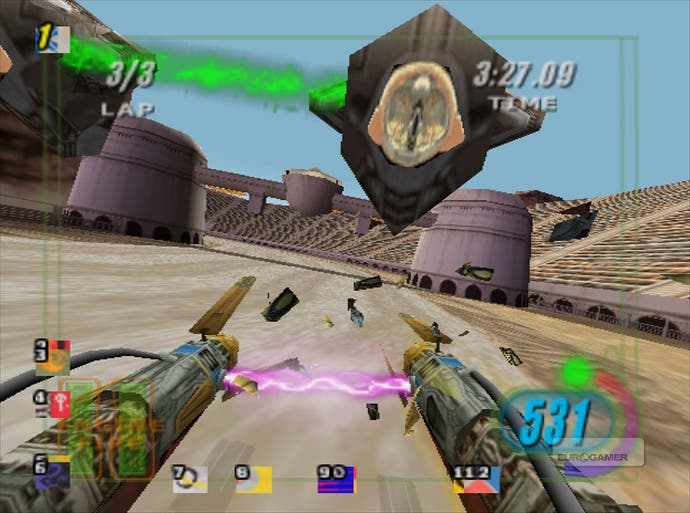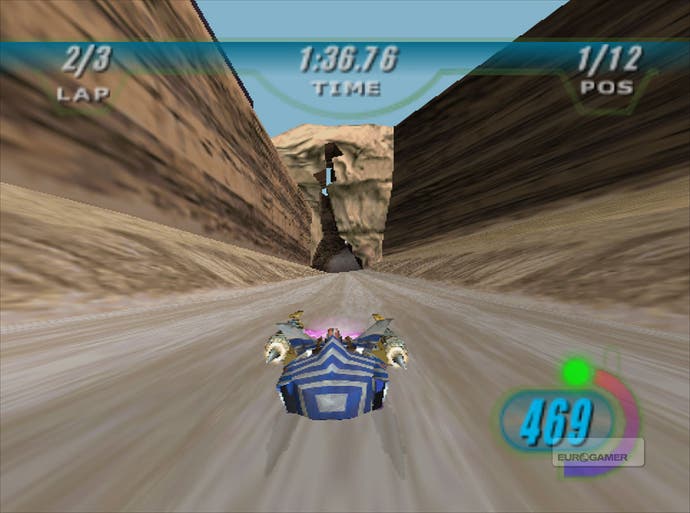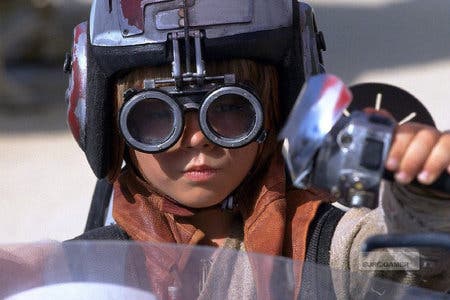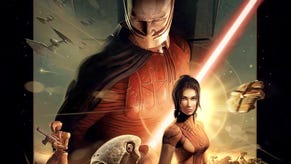Retrospective: Star Wars Episode I Racer
Pod damn!
Is it still fashionable to hate the Star Wars prequel movies? It would seem so, judging by some of the reactions I've read to the 3D re-release of The Phantom Menace that's just hit cinemas. I remember watching Episode I when it first came out in 1999, coming away disappointed but hardly surprised. It was, after all, a film saddled with an impossible weight of expectation. I didn't hate it. I just found it a bit boring, with a baffling plot (even the opening crawl had me confused) and far too many characters with silly haircuts. And even Darth Maul was rubbish.
The podracing scene was the obvious highlight. This enjoyable ten-minute sequence was technically brilliant - the sound editing in particular was amazing - and it must surely rank among the best action scenes in the entire saga. We should be thankful that LucasArts chose not to shoehorn a podracing section into its official Phantom Menace tie-in that appeared on PC and PlayStation. Instead, it wisely developed this standalone racing game for PC and Nintendo 64, and both titles were released to coincide with the film's premier.

History has shown that some of the best movie licences are those that focus on a key scene rather than try and cover the entire plot. That certainly held true here, as The Phantom Menace game was a hilariously ropey action-adventure while Episode I Racer was easily the most entertaining game to be spun off from any of the Star Wars prequels.
And over the years it has lost absolutely none of its appeal - or its speed. Playing it now, I'm surprised at how blindingly quick it is. The journey to the opening race is tedious - animated LucasArts intro, traditional text crawl, several selection screens including a wonky shop - but as soon as you're on the start line and the countdown completes, you're blazing through the desert canyons of Tatooine at ridiculous speeds.
It's fast yet for the most part the frame rate is admirably solid, although if you want a smooth ride on the N64, the 4MB memory expansion pack is almost mandatory. This fluid performance comes at the expense of graphical detail but overall it's a very agreeable trade off (and who cares about the sparse trackside scenery when you're bombing along at 600MPH?).

What's particularly pleasing is how forgiving the game is - at least in the opening, seven-race tournament. Unlike the WipEout games, where hitting the sides of the track often results in a dead stop, here you can bash into walls and smash through obstacles and largely get away with it. Your engines do take damage, however, but you can repair them during the race. Things get much tougher when you step up to the Semi-Pro and Galactic tournaments and compete on tracks that are tight and twisty. You even have to - gulp - use the brakes. This abrupt difficulty spike is perhaps the game's chief flaw. Fun quickly turns to frustration as you're forced to memorise the tracks rather than rely on reflexes alone.
Another disappointment is that many of the tracks lack true 'wow' moments. In similar games like WipEout, F-Zero X or Extreme-G you encounter huge dips and dizzying loops, yet Episode I Racer lacks those outrageous rollercoaster-style tracks.
But what those rival racers don't have is the Star Wars license, and that's something pretty special; something that can make a bad game tolerable and a good game great. You're not just piloting a futuristic hover-thing in some random sci-fi setting, you're podracing on Tatooine and other iconic planets in the Star Wars universe. And if that doesn't instil you with a real sense of wonder while playing then John Williams' rousing soundtrack certainly will. Everything becomes epic when accompanied by Duel of the Fates.

Podracing was popular. Episode I Racer shifted more than three million copies on the N64 alone, and in 2000, Sega whizzed its own podracing game into arcades. Titled Star Wars Racer Arcade, it was large, loud and brilliantly over-the-top. The deluxe cab sported a 50-inch screen and the player actually sat inside a pod modelled on Anakin Skywalker's racer. The speed and steering controls were cleverly based on those in the movie, with a separate throttle lever for each engine. By whacking both throttles forward and hitting the boost button you could reach incredible speeds. Best of all, up to four cabs could be linked together for multiplayer racing.
In 2000, LucasArts announced that a podracing game was coming to the Sega Dreamcast. There was speculation - or perhaps hope - that it might be a home version of the Sega arcade game. Instead, it turned out to be a direct port of Episode I Racer that didn't look a great deal better than the N64 version (the screenshots featured on this page are taken from the Dreamcast version, if you were wondering).
Looking slightly slicker was the sequel, Star Wars Racer Revenge, which was released exclusively for the PlayStation 2 in 2002. It featured a smaller selection of tracks (13 compared to the original's 25) and was more combat-focused as you were required to destroy rival racers by ramming them into walls. Shifting the emphasis from pure, flat-out racing was arguably a mistake.

If you fancy partaking in a little afternoon podracing on current hardware then playing Racer Revenge on the PS2-compatible PS3 is perhaps the easiest option. The N64 version of Episode I Racer is not available on Wii Virtual Console, despite LucasArts supporting the platform, and the PC version is a real pain to get running properly on modern machines (for many users it would be easier to simply run the N64 or Dreamcast versions under emulation).
As for Sega's Star Wars Racer Arcade, I'm guessing that the chances of finding a cab in the wild are very slim these days, so it'd be fantastic to see this particular title resurrected on XBLA or PSN. Sadly, I suspect even the Jedi Council would have trouble resolving the rights issues to make that happen.
There is another, however. Kinect Star Wars is due for release very soon and it features a podracing section that looks rather similar to the Sega arcade game. The controls are even the same, albeit with 'invisible' throttle levers of course. Whether it's possible to accurately control such a speedy racer using Kinect is debatable, but if it proves popular we may yet see another dedicated podracing game whipping up dust on the horizon.



